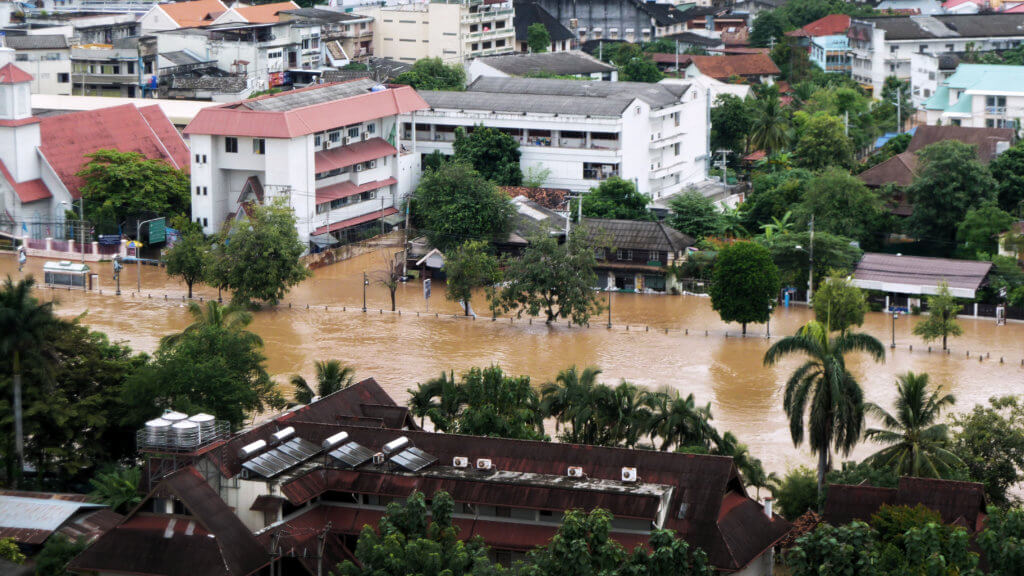Marsh | Closing the nat cat protection gap with effective physical climate risk mitigation
September 20 2023

The effects of climate change and its consequences are becoming more apparent in Asia with record-breaking heatwaves, floods, and landslides impacting businesses and communities. The region has experienced its largest number of extreme weather events in the past 30 years, with frequency expected to increase over the next two decades. [1]
Climate trends have driven demand for property damage and business interruption (PDBI) insurance, with reinsurers paying out a total of US$650 billion for natural catastrophe (nat cat) claims since 2017. [2] Yet, in Asia, the nat cat protection gap is estimated to be approximately 90% on average based on historical data. [3]
Insurance can play a significant role in reducing financial vulnerability and supporting economic recovery, and risk mitigation remains one of the most essential tasks to help reduce nat cat losses and helps with the availability and affordability of insurance. Doing so may require the help of a risk advisor with long-standing physical climate risk modelling and risk engineering expertise. With a data-driven methodology to help businesses mitigate their weather-related exposures and reduce potential losses, insurers can, in turn, more sustainably underwrite nat cat risks and better maintain an acceptable claims ratio.
“Partnering a risk advisor with insurance broking expertise further supports (re)insurers in their underwriting process to ensure the long-term availability of insurance products relevant to climate change, which in turn will enable society to become more resilient and attract new capital amidst an environment of uncertainty and persistent inflation.”
How risk advisors help businesses re-evaluate their physical climate risk mitigation plan
1. Assess physical climate risk exposures using the right data and models
Physical climate risk modelling provides an organisation with an understanding of potential losses for an asset or portfolio of assets across a variety of peril scenarios and timeframes (both near-term and long-term).
This process uses a combination of historical event data and downscaled global climate projections to identify the impact of different perils, from catastrophic threats — such as flooding and typhoons — to more chronic stresses such as droughts on a business’s assets and operations.
The results can provide the organisation with a detailed, asset-level view of damages and business interruption implications for specific perils, as well as an organisational-level perspective on key risks. It also provides insurers with the latest insured property data and assumptions on future climate conditions to improve risk selection and pricing.
2. Validate and translate model outcomes into actionable insights
Going more in-depth to validate the physical climate change risk model inputs for critical assets, risk engineering specialists can undertake site-specific surveys to better understand an organisation’s assets and vulnerabilities. More importantly, these surveys can also identify any weak links (such as lack of raised floors in flood-prone areas), assess the quality of controls in key locations, and provide practical risk mitigation recommendations to enhance resilience and reduce the maximum loss amount.
Aside from serving to validate physical risk modelling outcomes and helping to prioritise risk mitigation measures, demonstrating how physical climate risk considerations have been factored into enterprise risk management actions should also provide underwriters with greater confidence. Such actions can include evaluating the impacts of climate change on your supplier network and how they are managing these impacts.
Strong partnerships lead to more predictable outcomes
As there are varying physical climate risk models and approaches in the market, risk advisors with long-standing expertise in physical climate risk like Marsh Asia can help businesses to choose and implement the right models to provide actionable intelligence to enhance physical resilience.
Partnering a risk advisor with insurance broking expertise further supports (re)insurers in their underwriting process to ensure the long-term availability of insurance products relevant to climate change, which in turn will enable society to become more resilient and attract new capital amidst an environment of uncertainty and persistent inflation.
Marsh Asia continues to work with insurers and reinsurers to explore innovative solutions tailored according to industry and geography to bridge Asia’s nat cat protection gap. Parametric insurance is one such solution that is gaining in popularity as a complement to traditional PDBI cover, as it enables the insured to overcome issues (e.g. certainty of claims payout) associated with traditional cover.
Facing rising losses from extreme weather events, it is important for businesses to demonstrate to insurers a heightened attention to risk management. Businesses perceived as having strong risk profiles typically achieve favourable outcomes at renewal. Insurers, reinsurers, brokers, risk advisors and insureds must collaborate to strengthen risk management against climate change.
[1] (Swiss Re, 2021), Nat cat protection gap in Asia https://corporatesolutions.swissre.com/en/japan/insights/knowledge/resilience/nat-cat-protection-gap-in-asia.html
[2] (Swiss Re, 2023), The state of the reinsurance property catastrophe market https://www.swissre.com/risk-knowledge/mitigating-climate-risk/state-of-reinsurance-property-cat-market.html
[3] (Guy Carpenter, 2022), Natural catastrophe protection gap in Asia calls for collaborative innovation https://www.guycarp.com/content/dam/guycarp-rebrand/pdf/Insights/2022/2022.7-Protection-Gap-Publish-final.pdf
 |
Marshall Lee
Head of Climate and Sustainability Strategy, Marsh Asia
Email: marshall.lee@marsh.com |
-
Allianz General | Allianz General combines innovative protection solutions while powering social good to lead Malaysian market
The insurer proactively addresses emerging risks and evolving customer protection needs while giving back to the community.
-
Sedgwick | Asia’s Energy Transformation – Balancing Growth, Risk and Renewables
Energy market presents unique risks, especially in a region which includes China and Japan as well as developing nations like Vietnam and the Philippines.
-
Beazley | Turbulent Waters: the maritime energy transition challenge
Businesses are facing a complex transition to non-carbon energy sources amid a push to achieve net-zero emissions for the marine sector by 2050.
-
Aon | Navigating shifts in the global and Asia insurance markets
Neelay Patel, Aon head of growth for Asia, says the market in Asia is at an ‘interesting stage of the cycle’.
